|
Kohler
Company in World War Two
Kohler, WI
1873-Present
This page updated 9-27-2022.
An American Auto
Industry in World War Two Special Edition
I never intended to do a page on the Kohler Company, as the main product
lines with which I am familiar are its lines of plumbing fixtures,
porcelain products, and small engines for lawn mowers and garden
tractors. At least those are the ones with which I am most acquainted. I was therefore totally surprised while touring the
submarine USS Lionfish at Battleship Cove in Fall River, MA in June 2019
to find that all of the torpedo tubes in the boat were manufactured by
Kohler. I would never have expected this. Because of this
unusual World War Two product, I have added this page to my website.
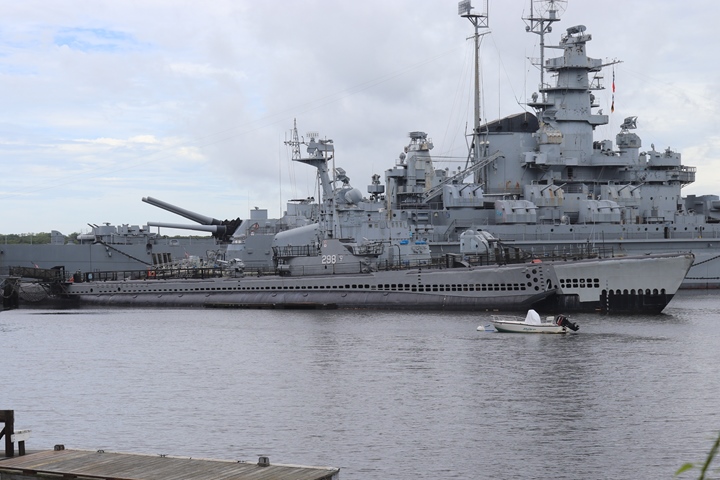
The USS Lionfish at Battleship Cove in Fall
River, MA. Author's photo.

The Kohler Company won the Army-Navy "E"
Award twice during World War Two.
Kohler Company in World War Two: The company had $45,957,000
in major contracts during World War Two. The diversity of the
products can be seen in Tables 1 and 2. Artillery shells, airplane
parts and torpedo launch tubes made up 72.7% of Kohler's major
contracts. It is unknown what type of airplane parts the company
made for the Army Air Forces. However, it was Kohler's second
largest dollar product group.
|
Table 1 - Kohler Company Major World War Two Product
Categories |
|
Product |
Customer |
Amount |
Percentage |
|
Shells |
Army |
$22,127,000 |
48.2% |
|
Airplane Parts |
Army |
$5,858,000 |
12.7% |
|
Torpedo Launch Tubes |
Navy |
$5,441,000 |
11.8% |
|
Generators / Power Plants |
Army |
$4,003,000 |
8.7% |
|
Fuzes |
Army |
$2,016,000 |
4.3% |
|
Generators / Power Plants |
Navy |
$916,000 |
2.0% |
|
Total |
|
40,361,000 |
87.7% |
Table 2 - Kohler Company's Major World War Two Contracts
The information below
comes from the "Alphabetical Listing of Major War Supply
Contracts, June 1940 through September 1945." This was
published by the Civilian Production Administration,
Industrial Statistics Division. |
|
Product - Customer |
Contract Amount |
Contract Awarded
|
Completion
Date |
| Fuze Percussion
- Army |
$261,000 |
6-1941 |
6-1942 |
| Shells - Army
|
$1,375,000 |
9-1941 |
3-1944 |
| Ordnance Material
- Army |
$214,000 |
12-1941 |
9-1942 |
| Fuzes - Army |
$257,000 |
1-1942 |
9-1942 |
| Shells - Army
|
$1,029,000 |
1-1942 |
12-1942 |
| Shells - Army
|
$2,761,000 |
1-1942 |
3-1943 |
| Shells - Army
|
$2,975,000 |
2-1942 |
12-1942 |
| Fuzes - Army |
$900,000 |
2-1942 |
1-1943 |
| Generator Sets -
Navy |
$183,000 |
2-1942 |
11-1942 |
| Fuze - Army |
$110,000 |
3-1942 |
7-1942 |
| Fuzes - Army |
$116,000 |
3-1942 |
12-1942 |
| Power Units -
Navy |
$272,000 |
4-1942 |
6-1943 |
| Fuzes - Army |
$372,000 |
4-1942 |
12-1943 |
| Vessel Equipment
- Navy |
$648,000 |
5-1942 |
11-1943 |
| Generators - Army |
$200,000 |
7-1942 |
3-1943 |
| Generators - Navy |
$73,000 |
8-1942 |
3-1943 |
| Generator Sets -
Navy |
$221,000 |
8-1942 |
7-1943 |
| Power Units -
Army |
$1,612,000 |
8-1942 |
11-1943 |
| Cranes - Navy |
$281,000 |
10-1942 |
5-1943 |
| Airplane Parts -
Army |
$5,100,000 |
12-1942 |
3-1944 |
| Airplane Parts -
Army |
$758,000 |
12-1942 |
11-1943 |
| Power Units -
Army |
$613,000 |
2-1943 |
9-1943 |
| Shells 105mm HE -
Army |
$415,000 |
4-1943 |
10-1943 |
| Electric Plants -
Army |
$132,000 |
5-1943 |
6-1944 |
| Electric Plants -
Army |
$51,000 |
5-1943 |
11-1943 |
|
Engine Generator Sets - Navy |
$80,000 |
5-1943 |
3-1944 |
| Power Plants -
Army |
$654,000 |
6-1943 |
5-1944 |
| Electric Plants -
Army |
$368,000 |
7-1943 |
1-1944 |
| Shells 105mm HE -
Army |
$1,598,000 |
7-1943 |
6-1944 |
|
Shells 105mm HE - Army |
$1,436,000 |
9-1943 |
3-1944 |
| Elec Generator
Sets - Army |
$221,000 |
10-1943 |
12-1943 |
| Elec Generator
Sets - Navy |
$409,000 |
11-1943 |
12-1944 |
| Generator Sets -
Army |
$103,000 |
11-1943 |
4-1944 |
| Power Units M121A
- Army |
$251,000 |
11-1943 |
7-1944 |
| Elec Generator
Sets - Navy |
$160,000 |
12-1943 |
8-1944 |
| Shells 105mm HE -
Army |
$787,000 |
2-1944 |
10-1944 |
| Trpedo Launch
Tubes - Navy |
$5,441,000 |
3-1944 |
8-1945 |
| Airplane Valves -
Navy |
$63,000 |
4-1944 |
12-1944 |
| Shells HE M42A1 -
Army |
$1,368,000 |
4-1944 |
12-1944 |
| Mobile Laundry
Pts - Army |
$139,000 |
6-1944 |
4-1945 |
| Mobile Laundry
Pts - Army |
$431,000 |
6-1944 |
6-1945 |
| Shell Parts 105mm
M1 - Army |
$1,200,000 |
6-1944 |
12-1944 |
| Shells Renovation
105mm - Army |
$60,000 |
6-1944 |
12-1944 |
| Shells 105mm HE
M1 |
$1,947,000 |
6-1944 |
3-1945 |
| Power Unit Parts
1M21A - Army |
$233,000 |
8-1944 |
4-1945 |
| Elec Generator
Parts - Army |
$362,000 |
9-1944 |
9-1945 |
| Engine Bearing
Shells - Navy |
$340,000 |
9-1944 |
1-1945 |
| Packing Services
- Army |
$405,000 |
11-1944 |
11-45 |
| Rotating Bands -
Army |
$886,000 |
11-1944 |
5-1945 |
| Shell Parts 105mm
M1 - Army |
$3,959,000 |
11-1944 |
6-1945 |
| Shell Parts 105mm
- Army |
$1,277,000 |
1-1945 |
2-1946 |
| Elec Generator
Parts - Army |
$166,000 |
1-1945 |
7-1945 |
| Mobile Laundry
Parts - Army |
$300,000 |
1-1945 |
7-1945 |
| Eng Generator
Sets - Army |
$193,000 |
3-1945 |
6-1945 |
| Elec Generator
Sets - Army |
$218,000 |
4-1945 |
9-1945 |
| Mobile Laundry
Parts - Army |
$53,000 |
5-1945 |
2-1946 |
| Total |
$45,957,000 |
|
|
Torpedo Launch Tubes: The company
was awarded a contract by the U.S. Navy for $5,441,000 in March 1944 to
produce torpedo tubes for submarines.
USS Lionfish Stern Torpedo Room:
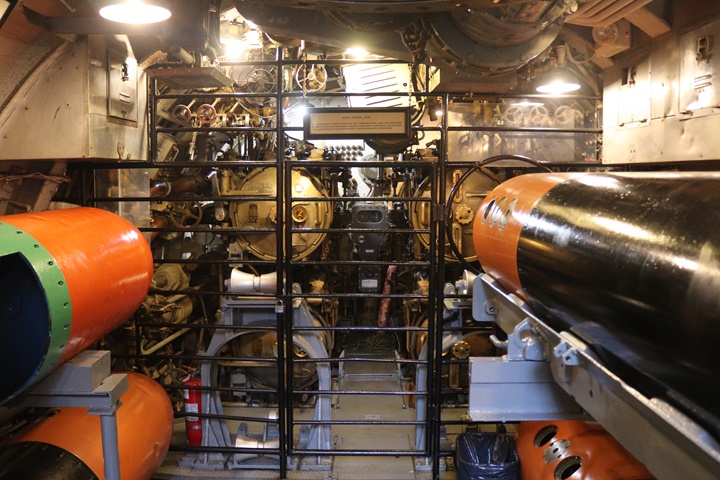
The self-guided tour of the USS Lionfish
starts at the front of the boat and finishes at the aft torpedo room.
Author's photo.
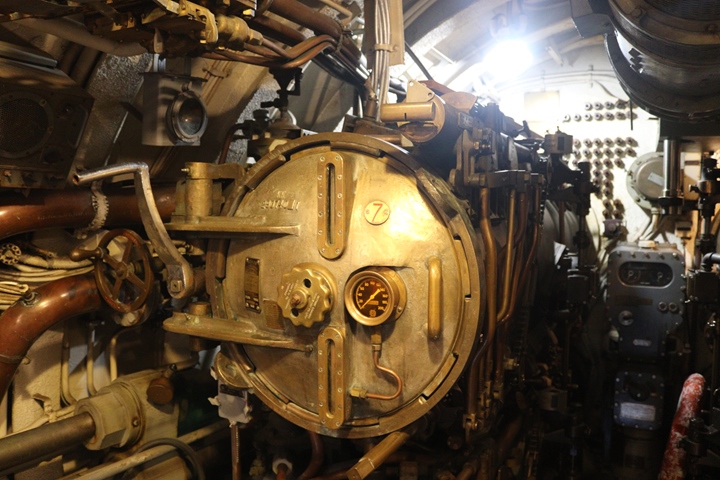
In looking at the torpedo tubes, I noticed
that they had manufacturers tags on them. I have never noticed
this on any of the other submarines I had previously toured.
Author's photo.
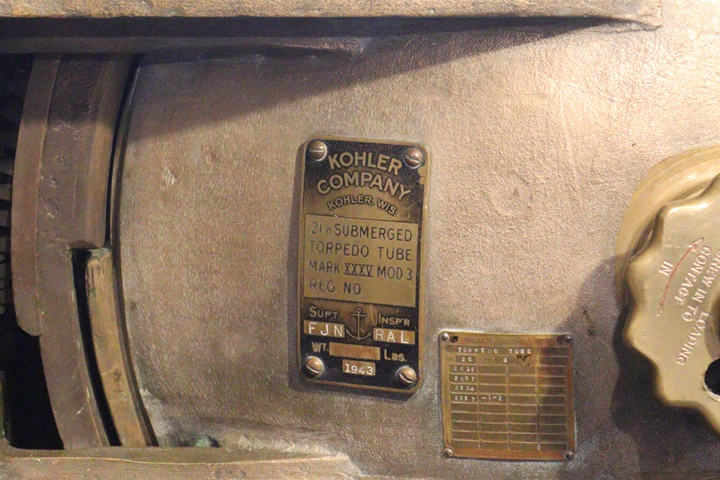
I was totally surprised to find that the maker of
porcelain plumbing products had built torpedo tubes to help win World
War Two. How cool is this? Author's photo.

Author's photo.
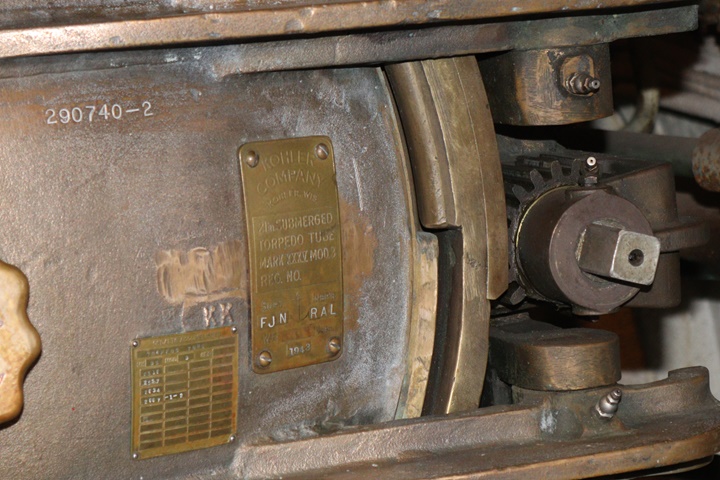
All four aft torpedo tubes were built by
Kohler. Author's photo.
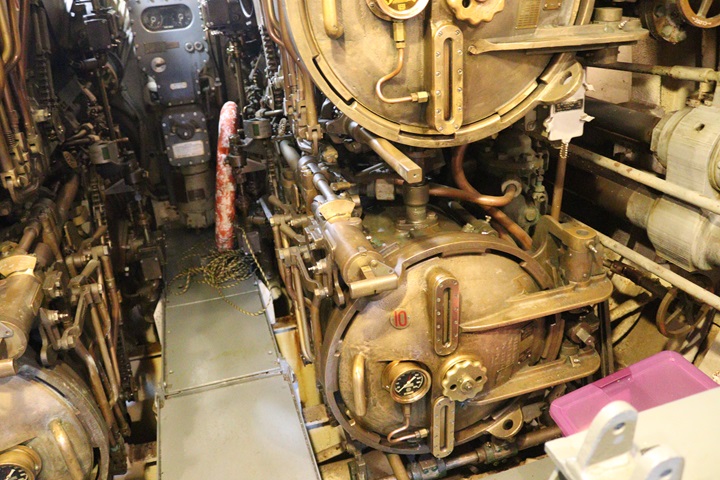
The torpedo tubes are all brass castings
Author's photo.
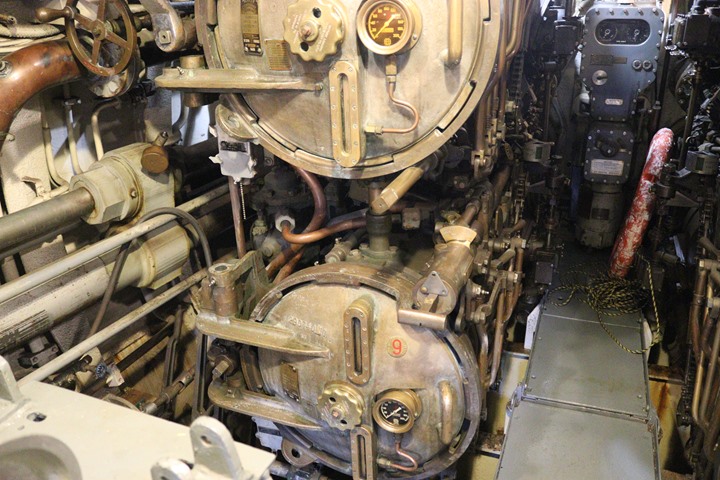
Author's photo.
USS Lionfish Bow Torpedo Room:
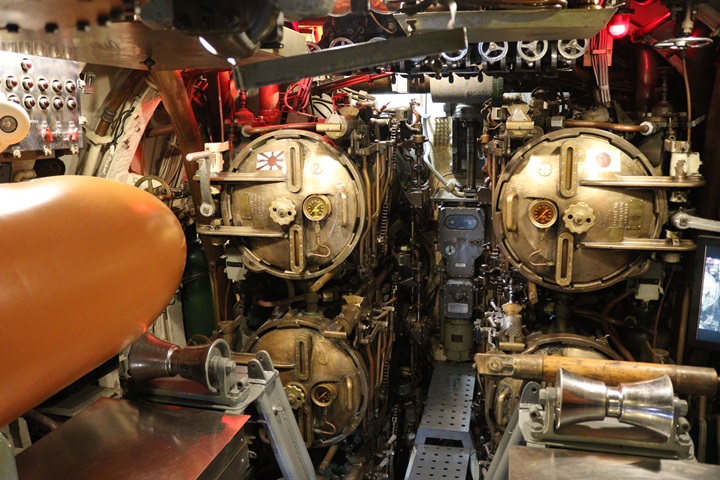
I finished the tour. Then I went
back to the front of the boat and down into the bow torpedo
room to see what I had missed. I had overlooked the Kohler data plates
on my first pass because there is more distance between where I was able
to view the tubes than at the stern tubes. These were also
Kohler-cast torpedo tubes. The bow has six tubes but only four can
be seen. Author's photo.
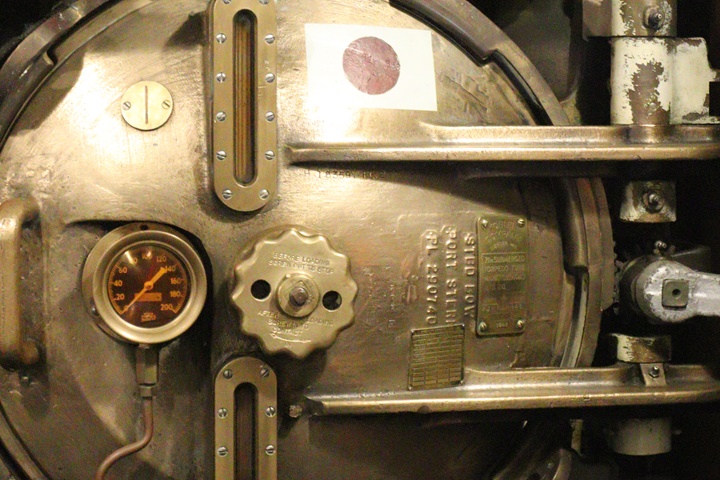
The torpedo tubes can be used either in the
bow or the stern. They just go on opposite sides of the boat.
Author's photo.
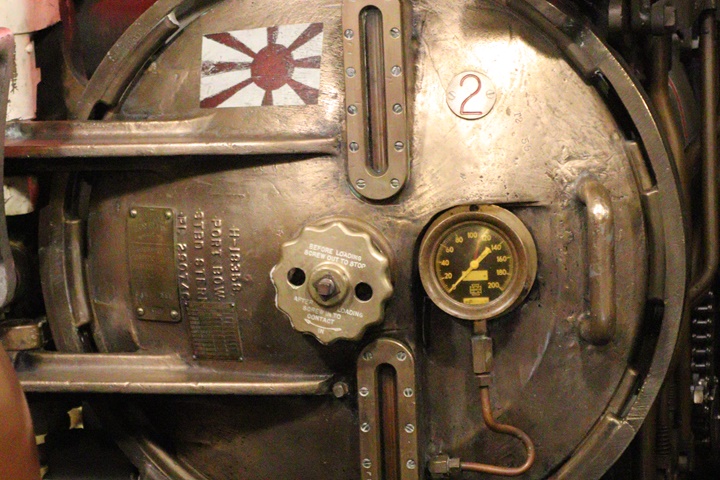
Author's photo.
It is unknown how many submarines were
outfitted with the Kohler torpedo tubes or how many were built.
Electric Boat Company of Groton, CT cast its own torpedo tubes for the
submarines it manufactured.

Workers at the Kohler plant are working on a
mold with a torpedo tube in it.
Shells: Artillery and tank gun
shells were the largest category of war material the company produced
during World War Two. This category comprised 48.2% of the
Kohler's World War Two output. Many of the contracts were for
unidentified types of shells. However, several contacts
specifically name the shell type.
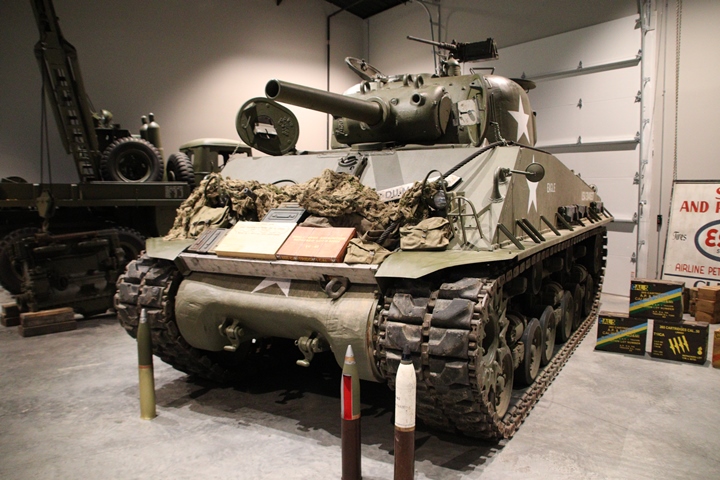
Kohler had at least six contracts for 105mm
high explosive shells. One application was for use in the
M4A3(105) HVSS Sherman tank. Author's photo added 9-27-2022.
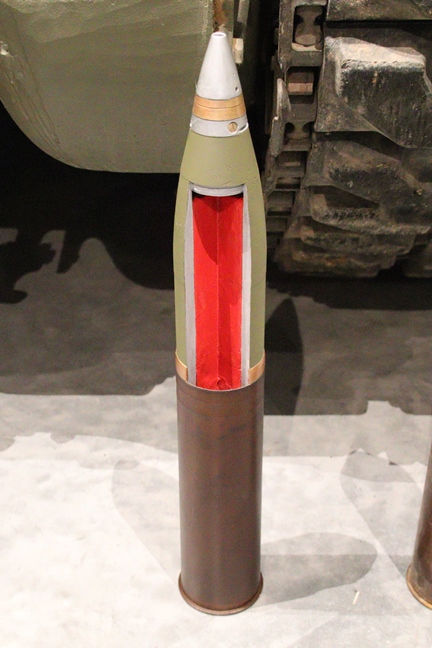
Author's photo added 9-27-2022.
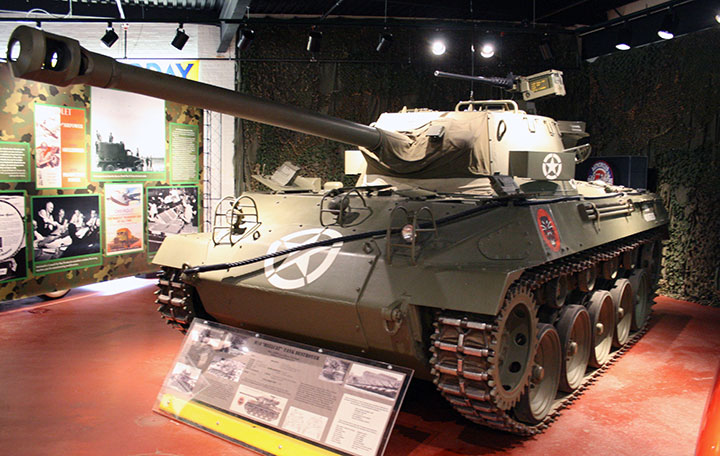
In April 1944 Kohler was awarded a $1,368,000
contract for the production of 76mm M42A1 shells. The company
produced the shell portion only, which was what went down range to the
target. These shells were for use in the Buick M18 Hellcat tank
destroyer. This M18 was on display at the Buick Museum in Flint,
MI in 2015. Author's photo added 9-27-2022.
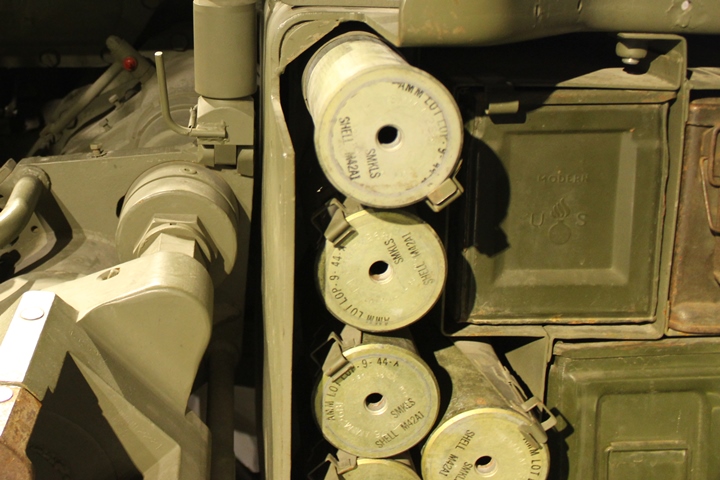
This image shows M42A1 shell casings in the
ready storage area of the M18. Kohler did not make the shell
casings. Author's photo added 9-27-2022.
Electric Generators / Power Plants:
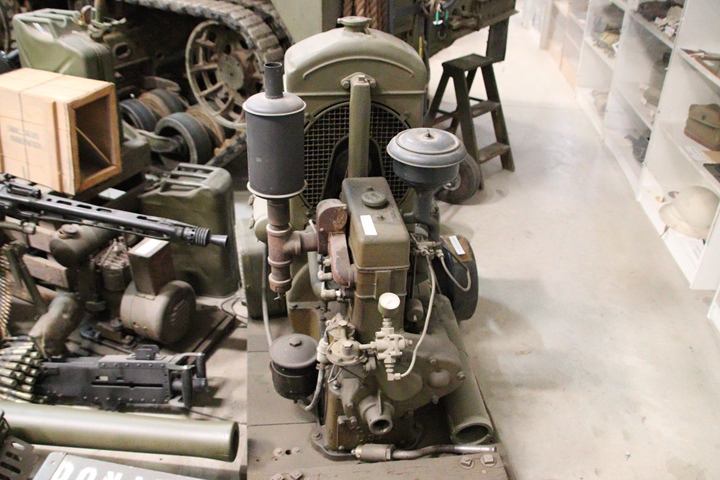
This is a Kohler Model 1M21A 115VAC
liquid-cooled power generator on display at the Roberts Armory in
Rochelle, IL. The U.S. Army Signal Corps designation for it was
PU-41/G. Author's photo added 6-2-2021.
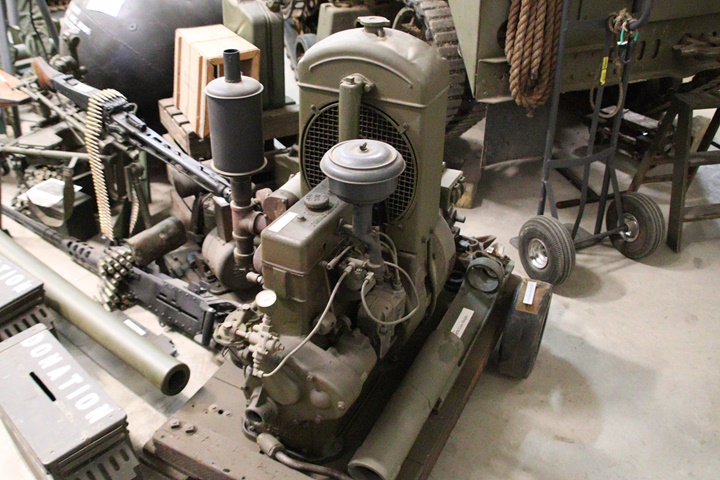
Author's photo added 6-2-2021.
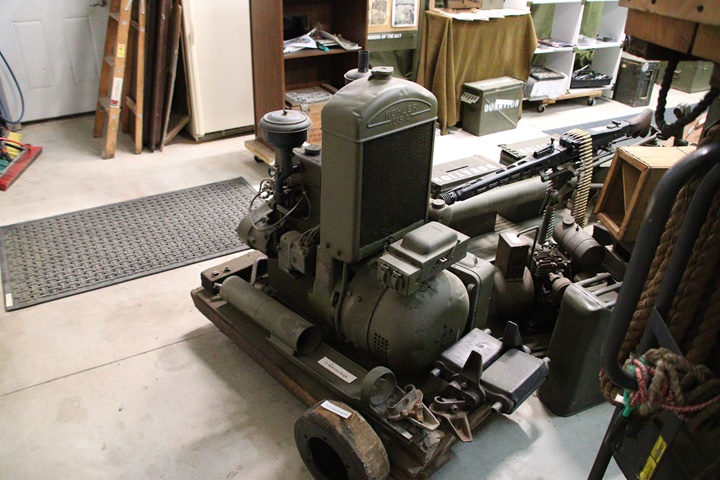
Author's photo added 6-2-2021.
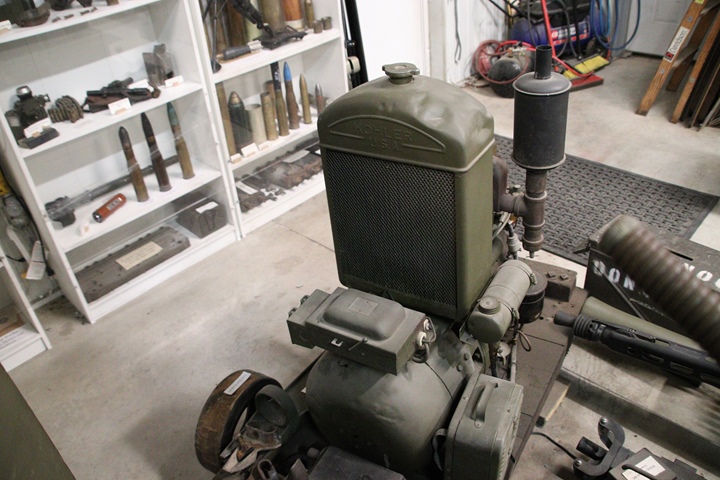
Author's photo added 6-2-2021.
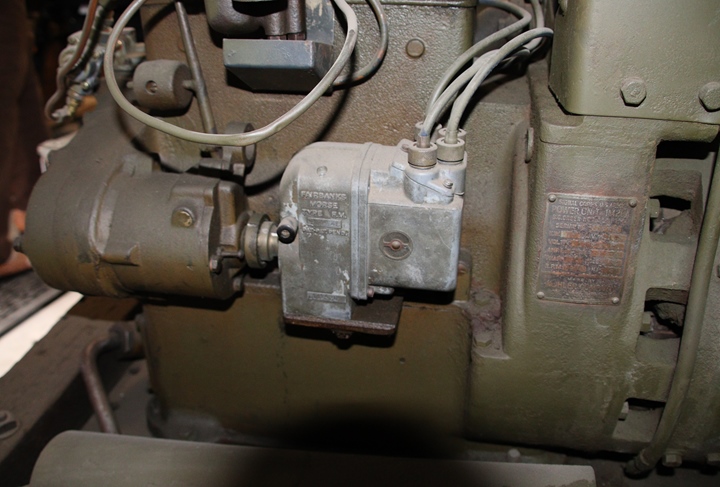
Author's photo added 6-2-2021.
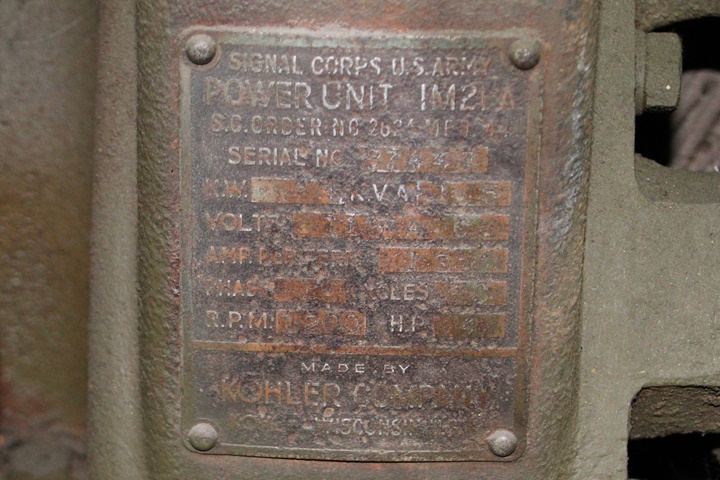
The serial number is 87447 and the engine
runs at 1,200 RPM. Author's photo added 6-2-2021.
Plumbing Supplies: During World
War Two hundreds of military bases and installations were built in the
United States. All of the barracks, along with many of the other
buildings on these bases, needed plumbing fixtures, sinks, commodes, and
urinals. Kohler supplied these important products to these bases.
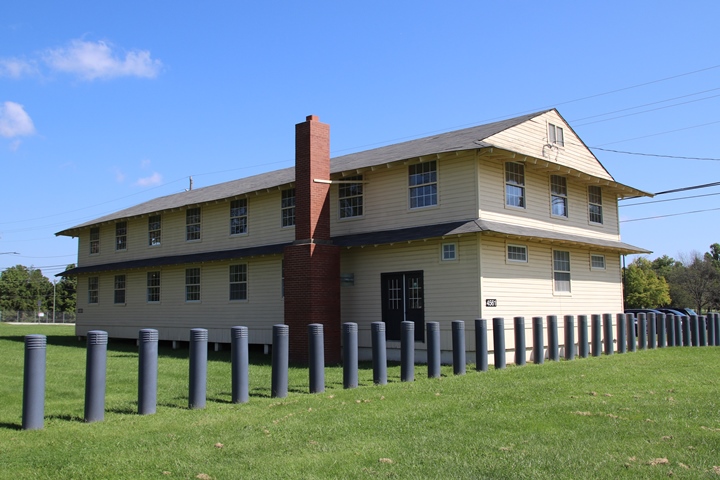
This is the sole survivor of originally
more than 1,000 barrack that were built at Fort Knox, KY during World War Two.
It is now on display the General George Patton Museum of Leadership at
Fort Knox. Author's photo added 9-27-2022.
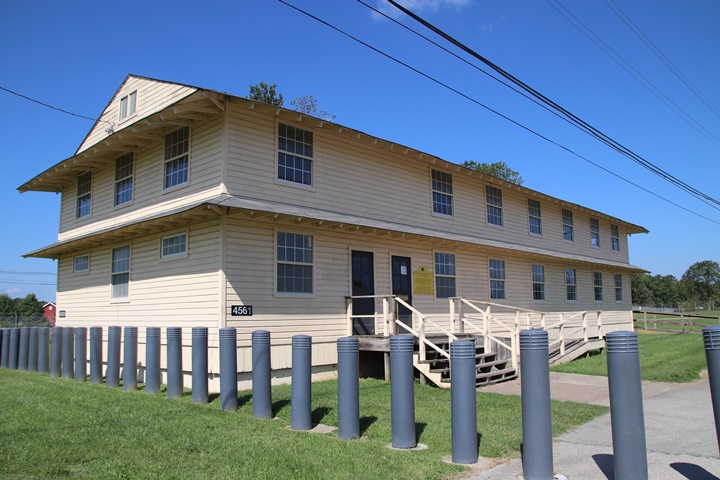
Kohler Company was one of many companies
that supplied plumbing for the latrines. There was too much
business for any one company to handle. Author's photo added
9-27-2022.
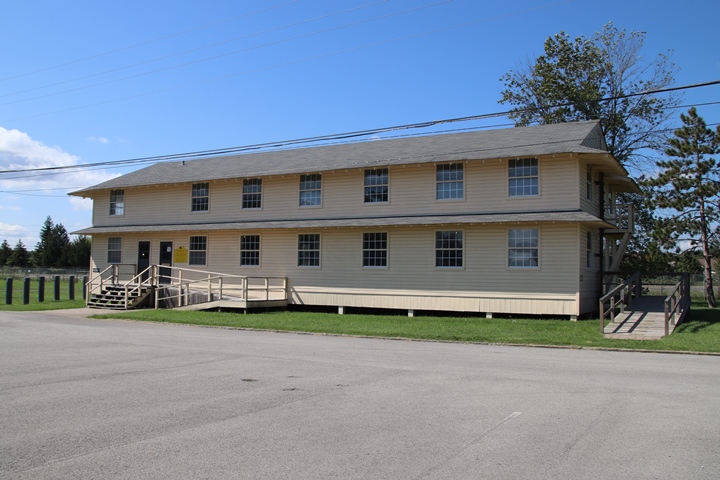
Barracks very similar to this were built at
over 1,000 Army and Army Air Forces bases during World War Two.
Author's photo added 9-27-2022.
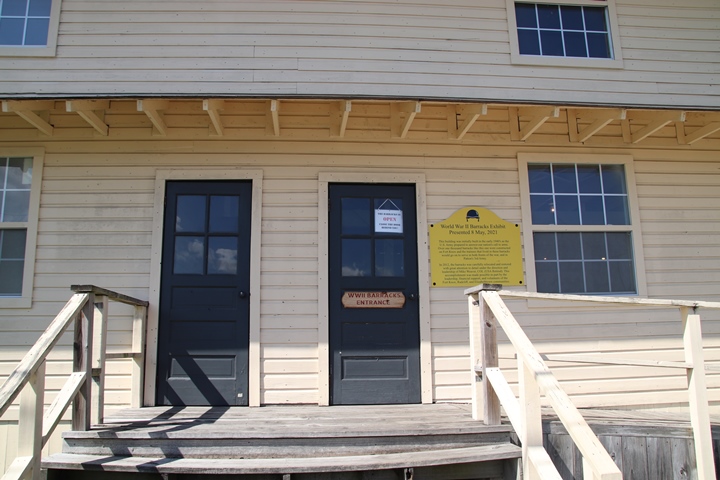
Barracks like these were still in use at
Fort Custer, MI, Fort Jackson, SC, and Fort Gordon, GA in the 1970s.
I know because I stayed in several of them. The ones at Fort
Jackson and Fort Gordon were painted white. I do not remember
there being two doors to the barracks at these two locations. I
think there was only one. Author's photo added 9-27-2022.
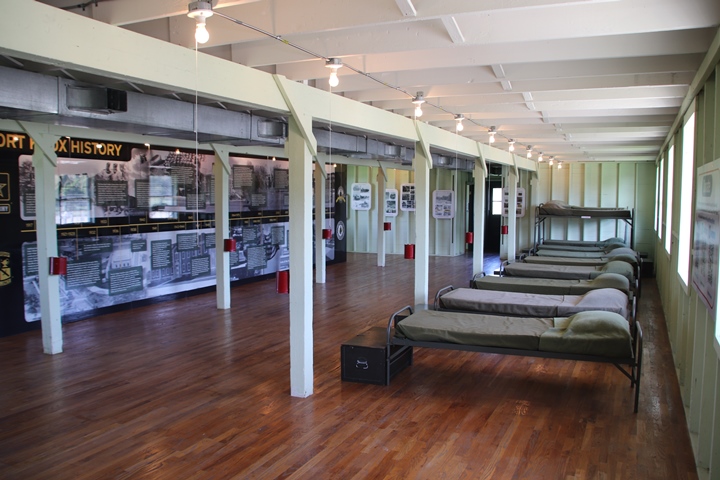
Fort Knox had nice floors. Fort
Jackson and Fort Gordon had linoleum floors. I think Fort Custer
had unfinished floors. The barracks there were rather rough.
Author's photo added 9-27-2022.
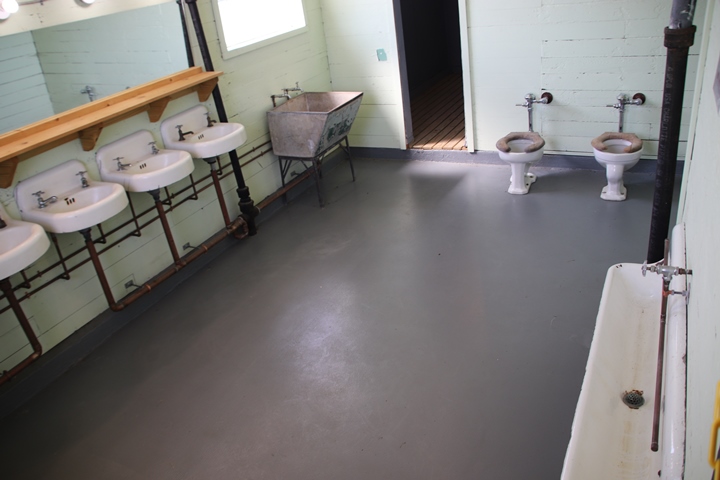
The latrines inside the Fort Knox barracks
were basic during World War Two. Author's photo added 9-27-2022.
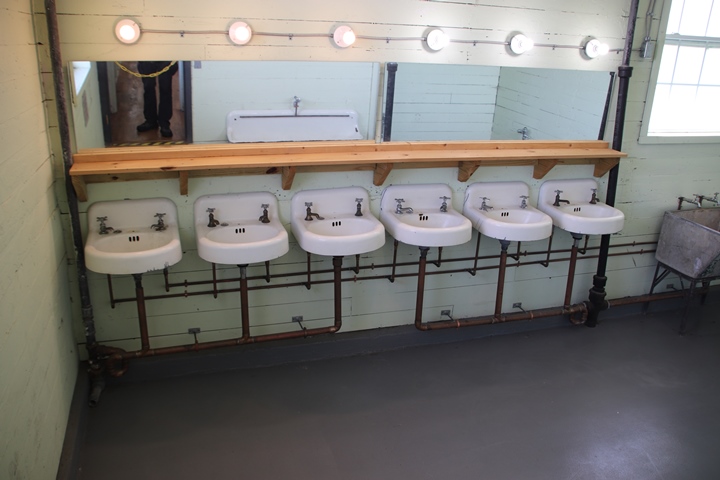
These were the sinks for the third part of
the three S's in the morning. Author's photo added 9-27-2022.
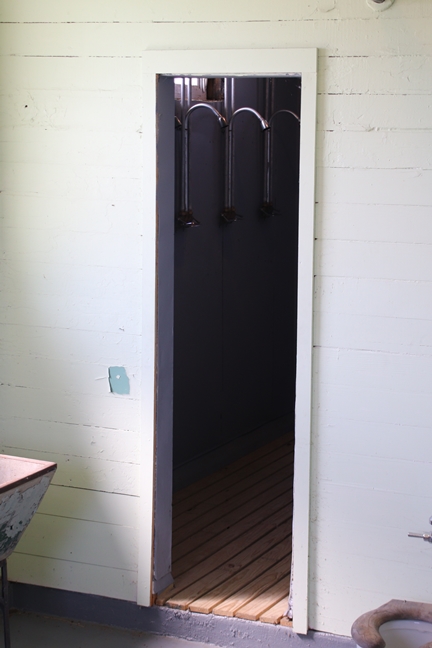
This was the shower area for the second of
the three S's in the morning. Author's photo added 9-27-2022.
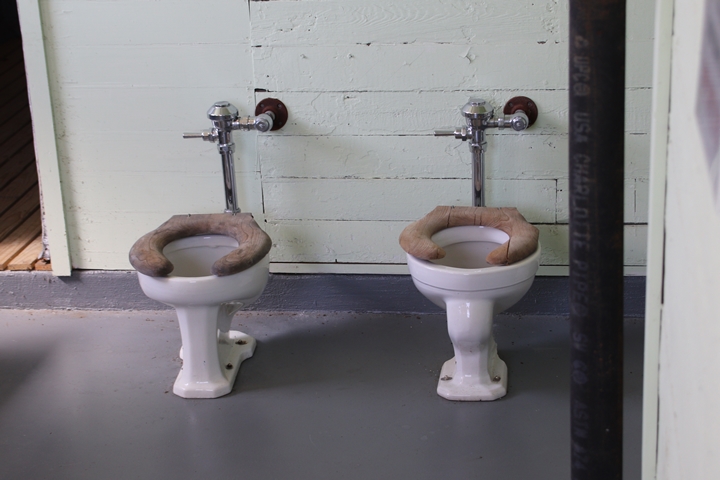
There was not a lot of privacy the
soldiers at Fort Knox when they did the first of the three S's in the
morning. At Fort Jackson, our latrine was set up different from
this. The commodes had stalls, but no doors. Author's photo
added 9-27-2022.
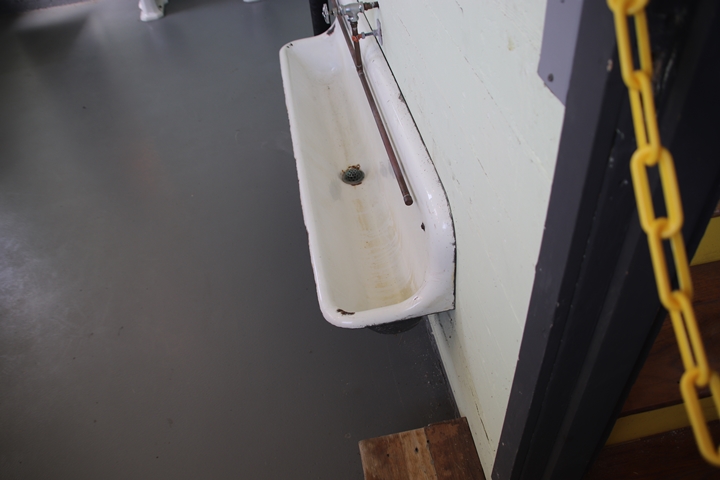
Author's photo added 9-27-2022.
For those who had a father or grandfather at
Fort Knox during World War Two, the last several photos illustrate the
total lack of privacy he had while in the latrine.
When the all-volunteer Army was formed,
barracks like this had to go away. Today, the recruits live in
college style dormitory buildings.
|
































